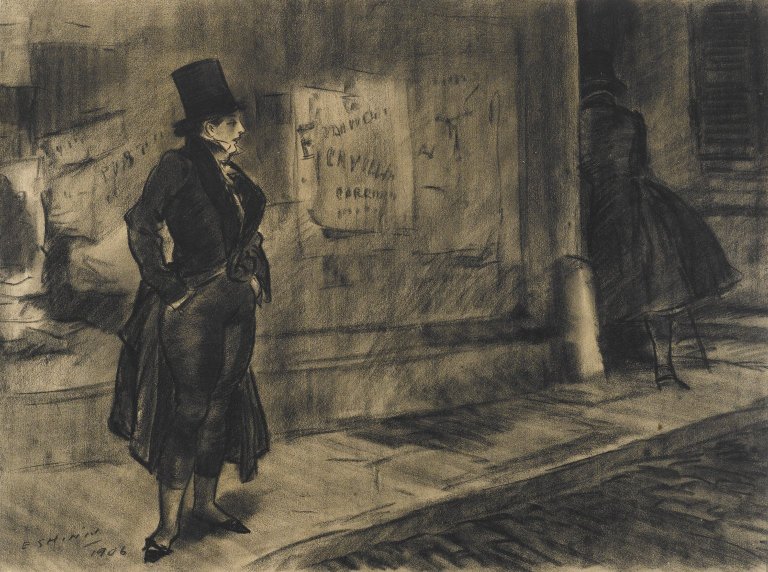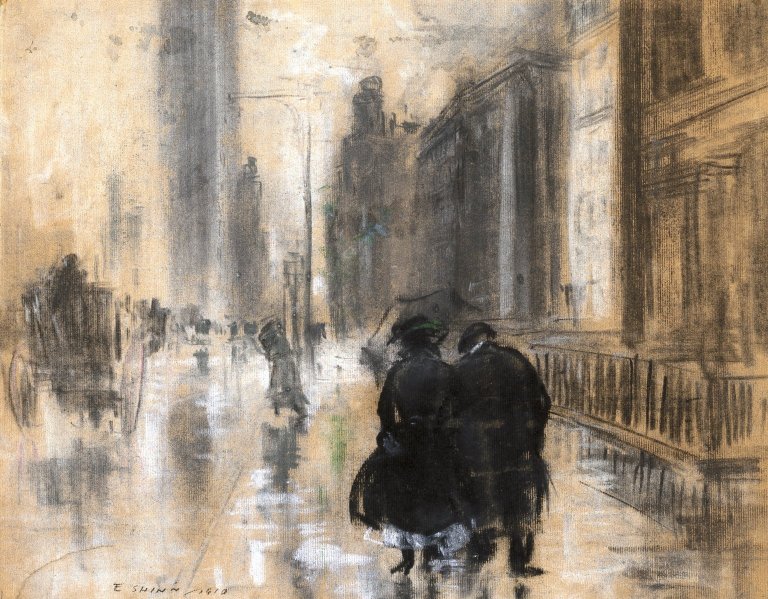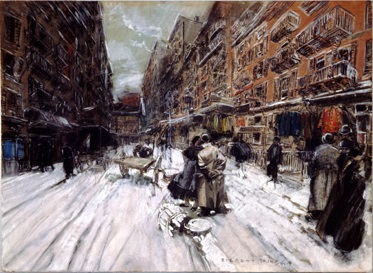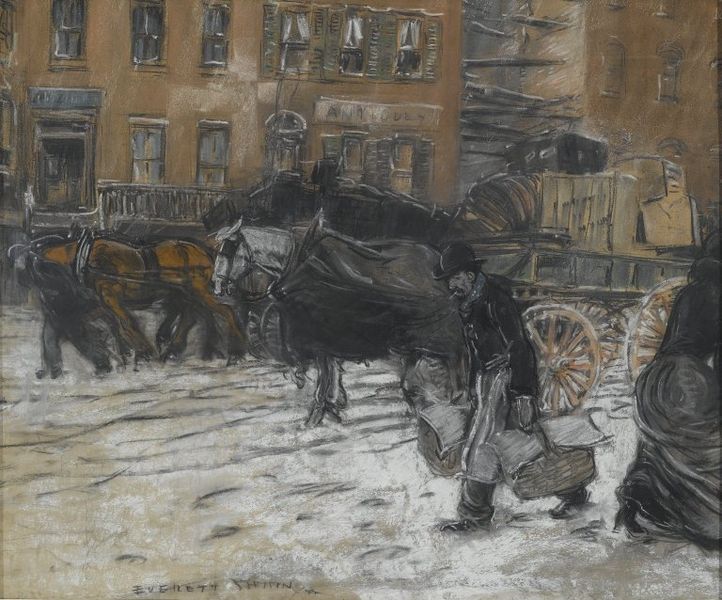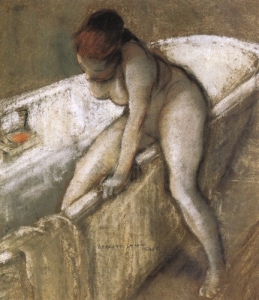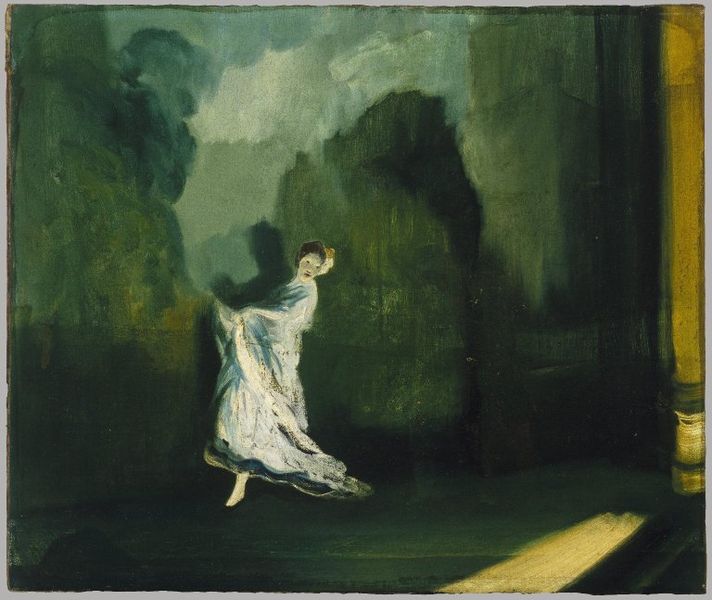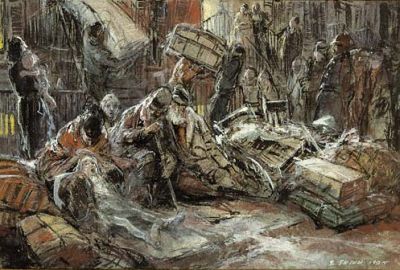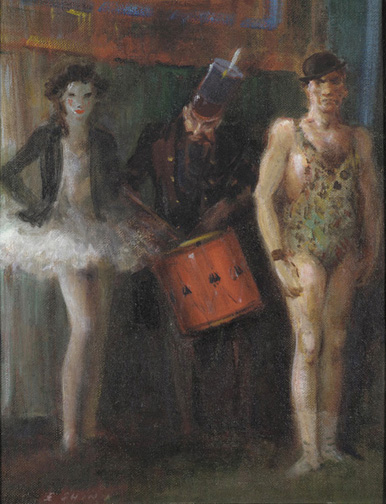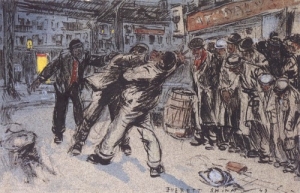<Back to Index>
- Painter Everett Shinn, 1876
PAGE SPONSOR
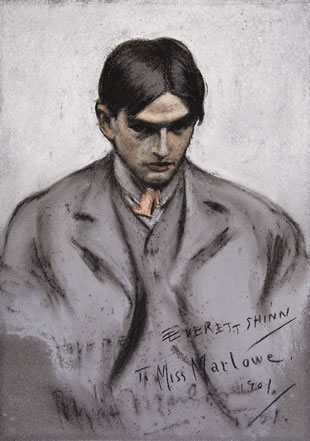
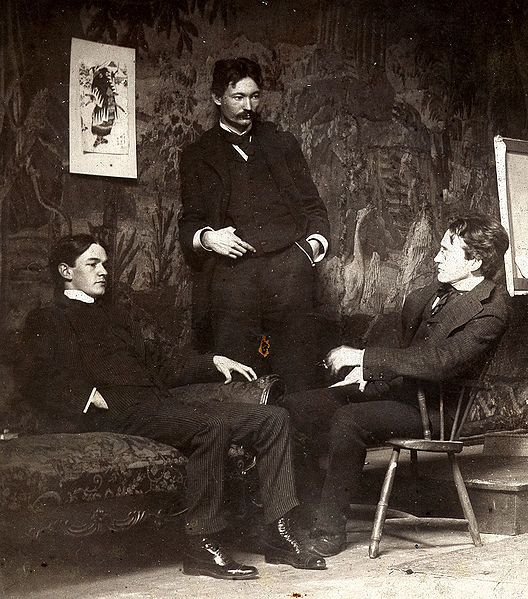
Everett Shinn (November 6, 1876, Woodstown, New Jersey – May 1, 1953, New York City) was an American realist painter and member of the Ashcan School, also known as 'the Eight.' He was the youngest member of the group of modernist painters who explored the depiction of real life. He is most famous for his numerous paintings of New York and the theater and of various aspects of luxury and modern life inspired by his home in New York City.
Shinn was born in Woodstown, New Jersey, a large Quaker community. His parents, Isiah Conklin Shinn and Josephine Ransley Shinn were rural farmers. He had two brothers: Warren, who was older and Harold who was younger. Shinn was named for the author Edward Everett Hale of whom his father was a great fan. In 1898, Shinn married Florence Scovel, known as "Flossie", another artist from New Jersey. In 1912, he and Flossie divorced. He was remarried to Corinne Baldwin in 1913 and they had two children, Janet and David. By 1933, Shinn had divorced two more wives and was the subject of many tabloid rumors. He suffered many losses during the Great Depression and sold very few paintings during that time. Between 1910 and 1937, Shinn held only one exhibition of paintings at Knoedler's in 1920. Between 1937 and his death in 1953, Shinn received several awards commending his innovative paintings and participated in several exhibitions. He died of lung cancer in 1953.
Shinn left Woodstown at the age of fourteen and enrolled at a technical institution known as the Spring Garden Institute in Philadelphia from 1888 - 1890. The school specialized in the teaching of mechanical drawing and architecture and was also attended by fellow member of ‘The Eight,’ John Sloan. Following his education, Shinn spent a year working at the Thackery Gas Fixture Works designing light fixtures. After being fired for doodling in the margins of his plans, his former employer urged him to go into a more creative field, citing the newspaper and magazine industries as examples.
He began his work for the Philadelphia Press in 1893 as an illustrator. Many, including Shinn, consider this the true beginning of his art career. In later years, Shinn would express his great dismay over the development of photography as the major source of pictorials in newspapers because it eventually largely replaced his form of art. He continually moved from paper to paper for the rest of his illustrating career, receiving a pay increase with each move. The attention to detail necessary for his newspaper illustrations is reflected in his style and later paintings, especially those of urban nature. In 1899, he quit the newspaper business and began working for Ainslee's Magazine, a magazine that also employed his wife, who was by that time a very successful illustrator and who brought in a good deal of the household income. Shinn also started displaying his work publicly in 1899 with mixed reactions. In 1900, he and Flossie traveled to Europe for him study and prepare to produce another exhibit. The trip greatly influenced his art in years to come during his visit, he saw European art that was focused on theatrical portrayals, as well as impressionist works.
Shinn has said of his experience at the Philadelphia Press:
"In the Art Department of the Philadelphia Press on wobbling, ink - stained drawing boards William J. Glackens, George Luks, Everett Shin and John Sloan went to school, a school now lamentably extinct… a school that trained memory and quick perception."
It was during Shinn's time in Philadelphia that artists John Sloan and Joseph Laub established the Charcoal Club as an alternative art school. The group, whose members were members of 'the Eight' such as Henri, Sloan, Glackens, Luks and Shinn, reached a peak membership of 38 and sketched nudes and did critiques of each others work. The club is often thought of as the establishing point of the Philadelphia group, later known as ‘The Eight’.
In 1897, Shinn was offered a higher paying job as an illustrator for the New York newspaper, The World. He moved there and was joined shortly there after by his wife, Flossie, and by other members of the Charcoal Club. Shinn enjoyed living in the city and observing the eccentric daily hustle and bustle exemplified by living in New York. Much of Shinn's life and opinions were reflected in his work. His life in New York was a major subject in many of his paintings. His fascination with the urban changes and city revolutions was evident in paintings like Fire on Mott Street and Fight. Shinn often depicted scenes of drama and violence, rallying for social change and urban understanding. Coinciding with the dramatic themes found throughout his work, theater was also a major subject in Shinn's pastels.
'The Eight,' also known as the Ashcan School, was a group of eight artists that rebelled against traditional academic artistic standards. Their name was established in 1908 when they held their single united exhibition together. The members of the group were extremely diverse in their subjects and painting styles, a fact that contributed to their short lived nature. The groups style is most commonly associated with the realist movement in modern art.
In the years of 1901 - 1910 Shinn began to experiment more with subjects in his work, gaining respect from art critics slowly but progressively. His paintings began to include the subject of theater, something he is known for now and he became an acclaimed user of pastels. During this time, he also did several murals, including one for the Belasco Stuyvesant Theatre that was eighteen panels.
Shinn's pastels were bold and brushy. His strokes were thick and his paintings communicated a sense of immediacy, sending a message similar to that of a snapshot. Through his many years, Shinn experimented in the mediums of oil, pastel red chalk, gouache and watercolors, though his most famous works were oil pastels. Like many painters associated with the realist movement, Shinn often depicted women and men from diverse races, classes and social backgrounds in public spaces together. This exploration of lower class subject matter is representative of the modern art movement. Many members of 'The Eight' had ties to these subject experimentations. Shinn, like is peers, was concerned with depicting real life and the world around him. Many of his paintings were inspired by his window views and walking through the parks in New York City, his most instrumental paintings were created during his time there.
Shinn was the youngest member of The Eight. Though Shinn's work was exploratory in subject matter and dramatic in style, it is considered most commonly in context with The Eight. Shinn's depictions of city life, the theater and high contrast spectacles that distinguished his work.
Shinn also had a lasting impact on the art world specifically in New York City. Through many of his works, Shinn documented leisure time and its impact on the American lifestyle.
The Fight, 1899 (Charcoal). In The Fight, a group of men stand on the right side of the drawing, watching a fist fight that is taking place in the center, right outside of a bar. Both black and white men are represented in the drawing, something unusual for Shinn's time period. The subject of the drawing (two men fighting) was very controversial. Fighting and brawls were typically associated with the lower class, a class that wasn't typically depicted in high art during Shinn's time. There is a bold stroked, yet sketchy quality to the piece that makes the subjects seem even more uneasy and off balance. The balance of the drawing is heavily on the right side of the painting with much more open urban space depicted on the left. This drawing is typical of Shinn because it shows lower class subjects in the urban landscape.
Theater Scene, 1906 (oil pastel on canvas). This painting is representative of Shinn's work in that it incorporates the theater, Shinn's favorite subject, and an intricate set design, another of Shinn's hobbies. The painting itself is of a group of dancers, clad in mostly white, onstage with a detailed backdrop of picturesque hills and a garden. The brush strokes are broad and wide and the painting has a sense of immediacy to it. The figures within the painting almost seem to be moving. The dancers are all dressed in white, a color symbolic of purity and one often associated with the upper class. The subject matter and content of this painting greatly contrasts with some of Shinn's other works that depict the lower classes as well as a diverse array of subjects. The painting has an almost dreamlike quality to it, making it seem more impressionist than realist in some parts.
